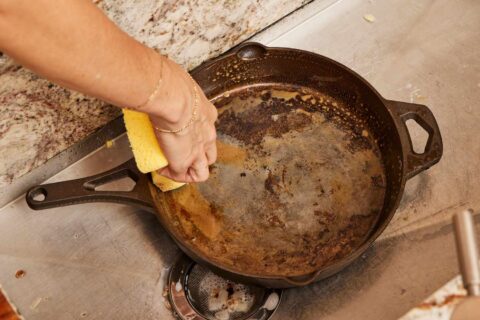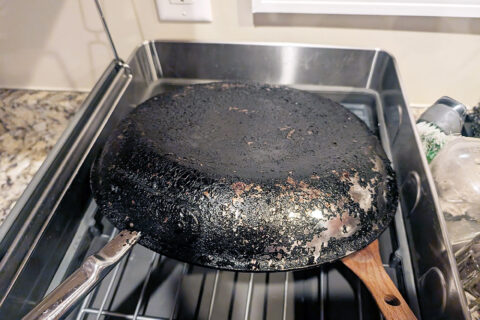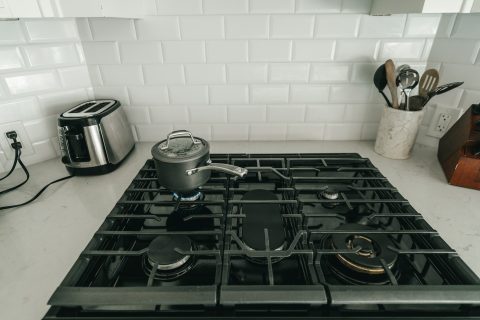
Cleaning carpets can be a challenging task. Stains, dirt, and daily wear make it difficult to keep them fresh. You might wonder where to begin or how to clean a carpet properly without damaging it.
With the right tools and methods, you can handle most messes at home. Regular vacuuming works wonders for maintenance, but deep cleaning keeps your carpet looking great.
In this post, you’ll learn easy steps to clean carpets yourself. From tackling stains with baking soda and vinegar to choosing the right carpet cleaner, we’ve got you covered! Keep reading for tips that work.
Jump to Section [Hide]
Understanding Your Carpet Type
Every carpet is different, and its material affects how you clean it. Knowing the type helps you choose the right tools and methods.
Common Carpet Materials
Carpet materials vary. Wool is soft and natural, but needs gentle cleaning to avoid damage. It shrinks or discolors with harsh products. Nylon handles tough cleaning well and resists wear, making it durable.
Polyester feels soft but flattens if not dried correctly after cleaning.
Olefin, often used in basements, resists moisture but burns quickly, turning into ash. A burn test can identify your carpet type. When tested, wool smells like burnt hair. Nylon melts, while polyester hardens after burning.
Always consider the material before choosing a cleaning method!
How Carpet Type Influences Cleaning Methods
Every carpet material needs its own cleaning method. Wool carpets are soft and natural, so avoid harsh chemicals. Use gentle cleaning agents like white vinegar or baking soda to protect the fibers.
Synthetic carpets, like nylon or polyester, handle stronger cleaners well but still need care during stain removal.
High-traffic areas on your carpet wear out quickly, and stains settle deep in thick fibers. For these spots, use a vacuum cleaner with strong suction first. Light carpets show dirt more easily; steam mops or hot water extraction work best for deeper cleaning.
Always match tools and products to the type of fiber for safe results!
Gathering Essential Cleaning Tools and Supplies
Start with the basics, cleaning supplies can make or break the job. Having the right tools on hand will save you time and effort.
Vacuum Cleaner
A vacuum cleaner is the best tool for cleaning carpets. Use it weekly to remove dirt and dust from carpet fibers. Pick one with strong suction and a HEPA filter if you have allergies.
Wet/dry vacuums work great for spills or deep cleaning.
Vacuum in slow, straight lines for better results. Remember edges and corners where dirt hides. For small messes, try a handheld vacuum or carpet sweeper. Regular use keeps your carpet fresh longer!
Brushes and Sponges
Use a scrub brush for deep cleaning. Its stiff bristles help lift dirt from carpet fibers. Focus on high-traffic spots and stains. Opt for softer brushes to avoid damaging delicate carpets.
Sponges work well for blotting stains with soapy water or natural solutions. Always use clean sponges to prevent dirt from spreading, and rinse them often for best results.
Cleaning Solutions
For tough stains, pick a commercial cleaning solution in a spray bottle. These potent products work well on carpets with heavy dirt or spills. Spray directly and blot with white cotton towels to avoid color transfer.
For natural alternatives, mix vinegar and water at a 1:1 ratio. Use this for daily floor cleaning or light spots. Baking soda also works as an excellent deodorizer sprinkle it on the carpet, let it sit, then vacuum thoroughly.
Always spot-test any cleaning product first!
Natural Alternatives
For an easy, natural solution, use baking soda and vinegar. Sprinkle baking soda over the carpet. Let it sit for 15 minutes to absorb odors. Then vacuum thoroughly. For stains, mix equal parts vinegar and water in a spray bottle.
Spray directly on the stain, scrub gently with a sponge or microfiber cloth, then blot dry.
Hot water works well too! Use a bowl of hot water to clean dirt without chemicals. Dip a rag in the water and wring it out before cleaning the area. Dry with a fan or keep windows open for airflow to prevent moisture buildup or mold growth!
Preparing Your Carpet for Cleaning
Get your carpet ready with simple steps. Start fresh and clean to make the job easier. Keep reading for helpful tips!
1. Vacuuming Thoroughly
First, move furniture out of the way. This will give you better access to every spot on your carpet. Then, use a vacuum cleaner with strong suction and attachments for edges and tight spaces.
Run the vacuum in two directions, up-down and side-to-side. This helps lift dirt hiding deep in fibers. Clean high-traffic areas twice for best results.
2. Spot Testing Cleaning Solutions
Test every cleaning solution in a hidden spot on your carpet. Pick an area under furniture or behind a door. Apply a little of the cleaner using a microfiber cloth or sponge.
Let it sit for 10 to 15 minutes. Check for fading, stains, or damage. If nothing changes, the product is safe to use on larger areas. This step prevents discoloration and helps protect your carpet fibers from harm.
3. Pre-Treating Stains and High-Traffic Areas
Spray a carpet-cleaning solution directly on stains or heavily walked-on spots. Let it sit for a few minutes so it loosens dirt and grime.
Use a clean, white towel to blot the area gently. Avoid rubbing, as this can spread the stain. If needed, repeat until the spot looks better.
Effective Carpet Cleaning Methods
Different carpets require different cleaning methods. Choose what best suits your carpet and tools to save time and effort!
1. Steam Cleaning
Use a steam cleaner with hot water and cleaning products. This method profoundly cleans carpets and removes stubborn dirt. Always extract as much water as possible after cleaning. Too much moisture can cause mold or foul odors.
Focus on high-traffic areas and stains during the process. Move slowly to let the machine work properly. Steam cleaning machines are great for quickly freshening cleaned rooms. Make sure your carpet dries fully to avoid humidity problems later.
2. Hand Cleaning with Natural Solutions
Mix ½ cup of vinegar with 1 cup of water for a natural cleaner. Spray the solution on the carpet, let it sit for 10–15 minutes, and blot with microfiber cloths or rags. This works well for dirt and light stains.
For tougher spots, combine baking soda and water to form a paste. Gently scrub it onto the stain using a sponge or brush. Let it dry thoroughly before vacuuming away any residue. This method is safe and avoids harsh chemicals often found in all-purpose cleaners.
3. Baking Soda and Vinegar for Stains
Baking soda and vinegar easily clean carpet stains. Sprinkle baking soda over the stain, then spray it lightly with white vinegar. Let it bubble for a few minutes, it helps lift dirt.
Scrub using a brush or sponge to loosen the stain. Once dry, vacuum the area thoroughly. This natural method works well on tough spots and simplifies your rug cleaning!
4. Dish Soap and Warm Water
Mix a few drops of dish soap with warm water in a small bowl. Use a sponge or soft brush to gently scrub the soapy mixture into the stain.
Blot the area with a clean, dry towel to absorb extra moisture. Repeat if needed for stubborn spots, ensuring no soap stays behind on your carpet fibers.
Tackling Specific Carpet Stains
Are you dealing with tough stains like pet messes or spills? Simple tricks for handling each one are available.
1. Pet Stains and Odors
Pet stains can ruin carpets. Act fast to stop odors from spreading. Blot the mess with a paper towel or cloth, don’t rub it! Use an enzymatic cleaner like OdoBan spray. It breaks down stains and smells without leaving residue.
The fresh scent helps keep your carpet smelling clean.
For homemade solutions, mix white vinegar and water in equal parts. Spray it on the spot, let it sit for 10 minutes, and then blot dry. Baking soda also removes lingering odors. Sprinkle it directly on the area after cleaning the vacuum once it is dry! Always test a small spot first to avoid damaging your carpet type.
2. Food and Drink Spills
Food and drink spills can quickly stain carpets. Act promptly to clean them. Blot the spill with a dry cloth or paper towel. Don’t rub it, as this spreads the mess. For most stains, use dish soap mixed with warm water.
For tougher stains like wine, coffee, or grease, try Blue Magic Carpet Stain and Spot Lifter.
Baking soda also helps lift odors from food spills. Sprinkle baking soda on the damp area and let it sit for 15 minutes before vacuuming. Avoid hot water on protein-based stains like milk, it sets them deeper into fibers! Keep carpet cleaning machines handy for large messes in busy areas of your home.
3. Nail Polish, Ink, and Grease Stains
Nail polish stains need care. Dab the spot with a clean cloth and acetone-based nail polish remover. Test first on a hidden area of the carpet to avoid damage. Do not pour directly; use sparingly.
Ink stains can be tricky. Spray hairspray or rubbing alcohol on the stain, then blot it gently, never rub. For grease, sprinkle baking soda to absorb oil, let it sit for 10–15 minutes, and vacuum it up.
Use dish soap mixed with warm water to tackle any leftover grease spots.
Proper Drying Techniques
Drying carpets well prevents moisture issues. Take your time to avoid mold or bad smells.
1. Blotting vs. Suctioning
Blotting uses towels to absorb moisture from the carpet. Press a clean towel gently on the wet spot. Do not rub, as this can spread stains or damage fibers. Repeat with dry towels until no more moisture is absorbed.
This method works well for minor spills.
Suctioning involves using a wet/dry vacuum cleaner to pull liquid from your carpet. This tool is excellent for larger messes or deep water removal. It quickly removes excess water and reduces drying time, helping prevent mold growth.
Use both methods together for the best results in challenging situations!
2. Air Drying Carpets
Spread the carpet flat in a well-ventilated space. Open windows to let fresh air circulate. Use fans to speed up drying time. This helps avoid damp spots that invite mold and mildew.
Avoid placing carpets back too soon. Check for moisture by pressing down with your hand; it should feel scorched. Air drying works best for small rugs or after light cleaning with natural solutions like baking soda or vinegar.
3. Preventing Mold and Mildew
Dry carpets quickly to prevent mold and mildew. Use fans, air conditioning, or a dehumidifier to speed drying. If the weather is nice, open windows for better airflow.
Blot wet spots instead of rubbing them. Avoid over-wetting during cleaning. Keep rugs off damp floors until fully dry! Mold can grow fast in moist areas, so act quickly.
Long-Term Carpet Maintenance Tips
Keep your carpet looking fresh with simple steps. A little care every week makes a big difference over time!
Regular Vacuuming
Vacuum your carpet twice weekly to prevent dirt and debris from piling up. High-traffic areas may need more attention. Use vacuum cleaners with strong suction for better results.
Area rugs and doormats can help reduce mess on carpets. They trap dirt before it spreads around your home. Focus on edges and corners, as they often collect dust that is easy to miss.
Save time by sticking to this routine!
Using Area Rugs and Mats
Place area rugs and mats in high-traffic spots. They trap dirt, saving your carpet from wear and tear. Use doormats near entrances to catch mud and debris before it spreads.
Clean rugs often to keep them effective. Shake them out or vacuum regularly for the best results. This simple step helps with household management while keeping carpets fresh longer.
Spot Cleaning Everyday Accidents
Blot spills right away. Use a clean cloth or paper towel to soak up liquids. Avoid rubbing, which pushes the mess deeper into the carpet. For sticky spots, try mild dish soap mixed with warm water.
Keep spot removers handy for quick use. Spray them directly on stains and blot gently. Mix baking soda and vinegar to lift tough spots if you prefer natural solutions. A no-shoe rule can help prevent accidents in the first place!
When to Call in the Professionals
Sometimes, tough stains or deep dirt require skilled carpet cleaners to learn when to ask for help!
Signs You Need Professional Cleaning
Deep stains that won’t budge signal you need help. Pet accidents and odors often need professional carpet cleaners, especially in carpets. Regular efforts may not remove all smells or marks.
If the carpet feels sticky after cleaning, it might be time for experts. Heavily soiled spots from years of use benefit considerably from dry cleaning methods or influential steam equipment professionals use.
Don’t let dirt pile up too long. Call them before damage sets in!
Professional Carpet Cleaning Services
Professional carpet cleaners can remove deep dirt and allergens. They use advanced tools like steam cleaners to make carpets look fresh. These services cost around $100 for a few rooms, but the clean results are worth it.
You also get insurance if anything gets damaged during cleaning. This means you won’t have to worry, it’s all on them! Regular professional cleaning extends your carpet’s life and improves air quality in your home.
The Bottom Line
Cleaning your carpet doesn’t have to be hard. Start by knowing its type and using the right tools. Follow simple methods like steam or natural cleaning for great results.
Regular care can keep your carpet fresh and extend its life.
If needed, call experts to handle tough stains or deep cleaning. A clean carpet means a cozy and healthy home!
Additional reading: How to Dispose of Old Carpet








